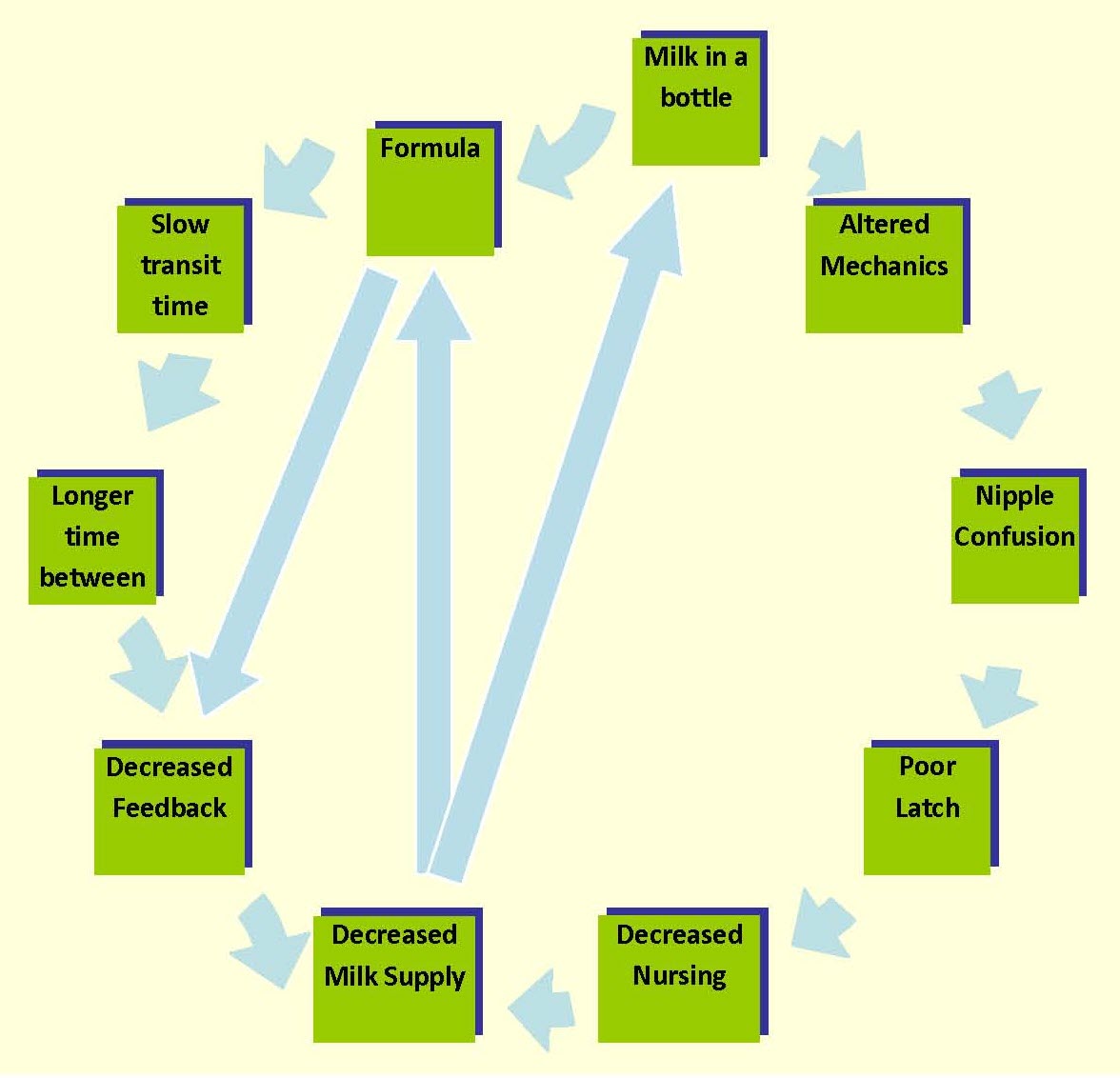MILK
Human milk is the preferred source of nutrition for infants, according to the World Health Organization (WHO), AAP and Canadian Pediatric Society (CPS). Ideally human milk is the sole source of nutrition for the first six months of life. The AAP recommends mother's provide breastmilk for their infants up to one year of age. The World Health Organization (WHO) recommends breastfeeding until two years of age. There is no age at which breastfeeding must be stopped. This should solely be the choice of the child and mother. Despite a constant attempt by companies which develop and market human milk substitutes (formula) to develop preparations which are increasingly similar to human milk no static preparation can compare to human milk which is constantly changing in response to the baby and mother's environment.
Who Breastfeeds?

Image by Kyrylo Ryzhov from Photospin
In the United States, 60-70% of mothers initiate breastfeeding, with over 40% continuing until at least 6 months. Breastfeeding is associated with increased maternal education, increased parity, married status and increased maternal age. Return to work by 6 months of age is associated with weaning by 6 months of age.1 Breastfeeding is less common among Hispanic and African-American women than among White women. (From AAP Pediatric Nutrition Handbook)
Advantages of Human Milk
Unique adaptations
Only human milk is uniquely adapted to the needs of human infants, and indeed to the individual human infant. For example, for a baby born prematurely, the mother's milk has a higher nitrogen content than milk produced by a mother of a term infant. The content of human milk varies from day to day and even from the beginning to the end of a feeding in a manner adapted to the needs of the individual infant. If a mother and her infant are exposed to a pathogen, such as an enterovirus causing diarrhea, oligosaccharides found in the mother's milk coat the gastroesophageal mucosa. Pathogens bind to the oligosaccharides which are then excreted in stool.
Ease of digestion
One major advantages of human milk is the relative ease of digestion. Human milk contains 70% whey proteins and 30% casein proteins, a ratio nearly opposite that of bovine (cow's) milk. The whey protein is generally more easily digested and promotes gastric emptying. The major whey protein is alpha-lactalbumin.
Increased immunological protection
Another major advantage of human milk is increased immunological protection. Studies of breast fed infants consistently show decreased rates of otitis media, gastroenteritis and a variety of other infections; and the effect is dose-dependent. Lactoferrin, lysozyme and secretory IgA are whey proteins involved in host defense which are not available to infants who are formula-fed. It is estimated that optimal breastfeeding world-wide would save an estimated 1 million lives each year from death by infection.
Other advantages
- Decreased risk and severity of allergic-mediated conditions, including asthma
- Enhanced maternal-infant bonding
- Improved long-term cognitive and motor skills in the infant
- More rapid post-partum weight loss and uterine involution following delivery
- Decreased risk of necrotizing enterocolitis in preterm infants
- Decreased incidence of urinary tract infections
- Protection against Crohn's disease, lymphoma, certain subtypes of type I diabetes mellitus
- Decreased risk of pre-menopausal breast cancer in women who breast feed their infants
- Economic benefits
1. BMC Pregnancy Childbirth. 2016 Jul 29;16(1):194. doi: 10.1186/s12884-016-0965-1.Determinants of breastfeeding initiation and cessation among employed mothers: a prospective cohort study.Dagher RK 1 , McGovern PM 2 , Schold JD 3 , Randall XJ 4 .
Economic Benefit
What is the estimated cost for feeding a newborn various preparations for one year?
Hint: on average, human milk or formula intake can be estimated at 24-32 ounces per day.
Annual Costs of Breastfeeding vs. Formula
| Food Source | Cost Per Ounce (retail) | Ounces made per can | Cost per year |
|---|---|---|---|
| Breast Milk | Additional cost might be considered for additional calories (food) a lactating mother may require. Early in lactation this is usually nil, since calories may be used from fat stores as the mother returns to pre-pregnancy weight | n.a. | Minimal |
| Powdered (Pow) Cow-milk-based formula (DHA/ARA*) | $0.19 | 160 | ? |
| Pow soy formula (DHA/ARA) | $0.19 | 160 | ? |
| Ready-to-feed (RTF) Cow-milk based formula (DHA/ ARA*) | $0.28 | 31.5 | ? |
| RTF soy based formula with DHA/ARA* | $0.25 | 31.5 | ? |
| RTF casein hydrolysate-based formula | $0.38 | 31.5 | ? |
| Pow Special formula for spitting up or "sensitive" babies | $0.18 | 169 | ? |
| Pow casein hydrolysis based formula | $0.28 | 115 | ? |
| Alimentum Powder | $0.28 | 115 |
*DHA is docosahexaenoic acid. ARA is arachidonic acid - long-chain fatty acids found in human milk but not bovine milk, commonly referred to as lipil
Go to the next page for the complete Annual Cost of breastfeeding vs. formula
Annual Costs of Breastfeeding vs. Formula
| Food Source | Cost Per Ounce | Cost per year |
|---|---|---|
| Breast Milk | Minimal | Minimal |
| Powdered (Pow) Cow-milk-based formula (DHA/ARA*) | $0.19 | $1274 - 1699 |
| Pow soy formula (DHA/ARA) | $0.19 | $1274 - 1699 |
| Ready-to-feed (RTF) Cow-milk based formula (DHA/ ARA*) | $0.28 | $1529 - 2039 |
| RTF soy based formula with DHA/ARA* | $0.25 | $2039 - 2718 |
| RTF casein hydrolysate-based formula | $0.38 | $2718 - 3624 |
| Pow Special formula for spitting up or "sensitive" babies | $0.18 | $1747 - 2329 |
| Pow casein hydrolysis based formula | $0.28 | $2039 - 2718 |
| Alimentum Powder | $0.28 | $2039 - 2718 |
It should be obvious that the cost for formula is substantial. Imagine what families could do with an extra $1000-2000!
Additional economic benefits are estimated to be as much as $331 during the first year from decreased visits to a medical provider and decreased hospitalizations for illnesses which might be prevented by breastfeeding.
How Much Milk?
Recall that healthy newborn infants need approximately 120 kcal/kg/day to gain weight at the desired rate of 15-30 gm per day. Both infant formula and breastmilk have the same average calories per ounce: 20 kcal/ounce.
(Note: 30 ml=1 ounce.)
Clinical Exercise:
You are counseling a mother of 2 week old infant at a well-child visit. The infant weighs 3.4 kg. His mother wants to know how much formula she should offer at each feeding.
How many ounces of formula per day would you recommend?
Advising Families
Topping Off
The practice of giving formula after nursing at the breast is called "topping off." Topping off sets the mother and baby up for decreased milk supply and premature weaning.
Avoid Topping Off:
Topping off sets up the vicious cycle demonstrated by the following diagram:
- In the early newborn period bottle feeding may alter the nursing mechanics leading to a poor latch and decreased milk transfer.
- Formula's slower transit time results in longer time between feeds, thus decreasing the number of nursing sessions.
- The mother's body is dependent on the baby's feeding cues in order to make enough milk to meet a growing baby's increasing demand.
Hidden costs to bottle-feeding
- The baby may need more formula than allowed by WIC. WIC does not actually give out formula. Families get vouchers for a limited amount of formula. Families eligible for WIC assistance can get 403 ounces of liquid concentrate of formula per month. This amount of formula when mixed correctly comes out to 806 oz or about 27 oz of formula/day. If the family is economical and gets the 1 lb 9.7 oz can of powdered formula with their vouchers, instead of liquid concentrate, this should provide 950 ml of formula per month or 32 oz. per day. (Four eight-ounce bottles). This is EXACTLY how much formula a six month infant should consume. If the parents run out of formula they have to purchase it on their own.
- Diapers are expensive. The average formula fed 6-month old has 2-3 stools per day, compared to the breastfed baby who may have one bowel movement every 2-3 days or even longer. So, a bottle-fed baby will use about 80 more diapers per month, and more wipes as well.
- Some healthcare costs can be prevented with breastfeeding over bottlefeeding. Formula fed infants get upper respiratory and ear infections at a higher rate than breastfed infants and will require healthcare appointments. Although the healthcare may be covered by health insurance, the parent may have to miss work; and if the parent is an hourly or day worker, this may result in lost wages.
- WIC eligibility is determined be each state, but must fall between 100-185% of the Federal Poverty Guidelines, which are issued each year by the Department of Health and Human Services. In 2017 185% of the FPC for a family of 4 is an annual income of $44,955, or $865 per week; for a single mother (household of 2) it is $29,637.
Take the Cost Challenge
Use the table below to determine what the "cost" for the WIC "free" formula (i.e. extra formula, diapers, and lost work days)?
Assume this family of two makes $655/week or $2620/month.
| amount | Unit Cost | Total Cost/Month | |
|---|---|---|---|
| Extra Formula | 240 oz | $.08/oz | ? |
| Extra Diapers | 80 | $.22 each | ? |
| Lost work days | 2 | $131/day | ? |
| Total | ? |
WIC "Cost" of "Free" Formula
What is the Percent of monthly salary of the "cost" of the WIC "free" formula (i.e. extra formula and diapers and lost work days)?
| amount | Unit Cost | Total Cost/Month | Percent of monthly salary | |
|---|---|---|---|---|
| Extra Formula | 240 oz | $.08/oz | $19.20 | ? |
| Extra Diapers | 80 | $.22 each | $17.60 | .? |
| Lost work days | 2 | $131/day | $262.00 | ? |
| Total | $298.8 | ? |
For more information on Texas WIC food packages and a comparison of breastfeeding food packages versus non breastfeeding food packages link here

Image based on Krystal Revai's original
Look at the imaga above and answer the question following.




